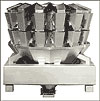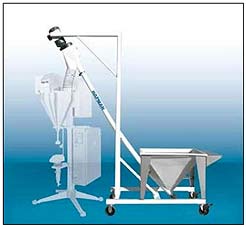Packaging Line Integration
Packaging
line integration is all about efficient mechanical functioning of your
packaging line to ensure smooth product flow and transition from machine to
machine with optimum line speed. As you know that packaging lines,
now-a-days, handle various kind of packaging needs for a variety of products
and packaging designs and sizes keep on changing regularly. So, the
flexibility of packaging line has become very important and challenging
factor in the process of line integration.
A successful packaging line must be flexible enough to accommodate fast
changeover. And you may find it difficult to design packaging line for your
product-driven company without outside assistance.
Every packaging line integration focuses on the following factors:
Design and installation of Conveyor Systems
Traditionally, conveying systems were designed without paying much
attention to drive dynamics, the forces imposed on the conveyor and product,
or the effects of these forces on container stability. Present designs are
based on the average running speed requirements and mechanical longevity.
This results in typical design standards considering only rough estimates of
the loading; combined with factors, which represent the number of start-ups
and the amount of product slippage.
In recent years, increasing demands, economics, and environmental concerns
have placed enormous pressure on production facilities to increase operating
speeds, reduce wastage, reduce rework and cut manpower requirements. These
changes have pushed traditional design methods to the limit of there
effectiveness. In addition, the aesthetic appeal of complex container shapes
and the use of lightweight plastics has resulted in a new generation of
stability problems associated with the transport and control of containers
by conveyor.
Transfers Between Conveyors and Machines
The most common types of conveyor-to-conveyor, conveyor to machine or
machine to conveyor transfers are:
- Butt end: A butt end transfer is when two conveyors are
literally put together in line in such a manner that one chain is short
of touching the other chain by at least 1/4".
- Side transfer: A side transfer is when two conveyors are
placed side by side so that the package is guided via angled guide rails
from one conveyor onto the other.
- S-curve transfer: A S-curve transfer is when two conveyors
run parallel together in an elongated S form so that the guide rails are
straight and the conveyors flex at the transfer.
» Read More On
These Transfers

In general, conveyors are critical elements in any packaging process, which
are grossly misunderstood and poorly manufactured. This is mainly due to
non-packaging people and some packaging people thinking that conveyors are
non-value added items that are:
- Not a major item or consideration.
- The last think considered in line design and the last item
purchased.
- Cheap units for moving inputs from machine to machine.
- One conveyor type is as good as another.
This thinking can be disastrous for many packages.
Speeds, feeds, dynamics and loads for Interconnecting Machinery
The common requirement of conveyors is to transport containers from machine
to machine, and finally to storage facilities. In general, each machine will
have different requirements in terms of container spacing, linear infeed and
outfeed speeds, method of infeed, container orientation and container
control. In order for the production line to function smoothly, the
conveying system must provide the required changes in pitch and speed, and
must also serve (when required) as a reservoir of containers to help level
out fluctuations in machine operation. In addition, the conveying system may
also have to convert from single to multi-lane or mass flow and visa versa.
All of these requirements must be met without tipping, spilling, jamming, or
damaging the containers.
 Compatibility
of Interconnecting Machinery
Compatibility
of Interconnecting Machinery
A packaging line should try to balance its machinery with compatible
function type. Function type means the method of operation, which can be
either continuous or intermittent. Most low speed lines generally have
intermittent motion machinery. High-speed lines usually have only continuous
motion machinery. Medium speed lines could be a mix of both. There usually
are tremendous problems when an intermittent machine is coupled to a
continuous motion machine.
The best way to solve the mix is to place a buffer between the two
elements. These two motions are almost impossible to line shaft mechanically
but could be electronically line shafted, but with great difficulty. It is
possible to effectively run an intermittent motion on top of or within a
continuous motion machine or visa versa. These types of new high technology
machines require proper designs and well-trained skilled operators.
Integrating Manual Operations With Automatic Machinery
Human beings are the most resilient, flexible and adaptable element in the
packaging process. Unfortunately people have the following characteristics:
- They are the most unreliable on a day-to-day requirement.
- They are the most inconsistent and quality varies from person to
person.
- They have the least endurance versus machines.
- They are greatly restricted in weight lifting, reach and movements,
especially if they are repetitive in nature.
Because of this, great care most be taken in designing human
involvement in any packaging process. In general, as the packaging process
goes faster and/or weights or manipulations increase, it is imperative to
design out all human intervention just from the standpoint of health and
safety, regardless of cost justification.
If human involvement is to be designed in as part of the packaging process
such as packing, palletizing, etc., then the following conditions must be
considered.
- Ergonomics or the minimum human movements to complete the required
task at the proper heights and weights. Rotating or cyclic movements of
the wrists, neck, torso and arms should be eliminated or minimized at
all costs.
- Safety
- Eliminate or guard pinch points in the work envelop.
- Maximum noise levels should be 80 decibels steady and 85 decibels
for short peaks.
- Establish and maintain strict house cleaning rules.
- Minimize walking and relieve long-standing periods.
- Rotate people after predetermined time periods.


 In general, conveyors are critical elements in any packaging process, which
are grossly misunderstood and poorly manufactured. This is mainly due to
non-packaging people and some packaging people thinking that conveyors are
non-value added items that are:
In general, conveyors are critical elements in any packaging process, which
are grossly misunderstood and poorly manufactured. This is mainly due to
non-packaging people and some packaging people thinking that conveyors are
non-value added items that are:
 Compatibility
of Interconnecting Machinery
Compatibility
of Interconnecting Machinery